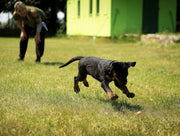
Many of us dream of a well-trained dog. It may be difficult to achieve because of a lack of time or too many distractions at home. How are you supposed to teach your dog how to stay if you have kids running around?
Since many dogs know how to sit when instructed, I wanted to break the myth that teaching a dog how to stay was hard. If your dog does not know how to follow the "sit" command yet, you should start there.
I included a short guide in an article about German Shepherds, but it works for all dogs. Scroll down in the article until you see "Example: Teaching Your German Shepherd How To Sit."

There are many benefits to your dog following the command "stay." For instance, you may use it at home when new people arrive, so your dog doesn't jump on them. Likewise, you may use it in public, so your dog stays calm off-leash in a park.
When not to use the command "stay"
There are times when I don't recommend using the command stay. Please don't use it when you truly leave your dog out of your sight. For example, if you are entering a store or a building and telling him to "stay" outside, it could be dangerous.
Teach your dog how to stay in 6 easy steps
I remember thinking a few years ago, "how are you supposed to train a dog to do a series of tasks?"
The answer is pretty simple: teach each small task separately. If you think your dog is untrainable, you may want to read this article I wrote: How do I know if my dog is uncontrollable?
The trick is to start small, and from a step your dog already knows how to do. For example, your dog needs to know how to sit first because you teach them how to stay.
Before you start

Before starting your training session, choose a quiet place with no distractions. For example, if you are at home, it may be a room away from other people in your household and void of dog toys.
If you are outside, make sure no one else is around. However, I recommend you start inside before taking this exercise outside.
It would be helpful to walk your dog before training him. Walking dogs tire them out, and they are less excited afterward.
Although I will outline six easy steps to teach your dog how to stay, there are not to be completed on the same day or in a row. It will take time.
I recommend you train your dog for short 3-5 minute sessions a few times a day. You might only be able to complete steps 1 and 2 the first day or two, and then you can continue to the other steps.
Step 1: ask your dog to sit and pick cue words
- Have your dog start in the sitting position. If your dog knows how to lay down, you may also start in that position.
- Pick a cue word: it can be "stay" or "wait," for instance. For now, pick it but don't say it.
- Pick a release word: it can be "OK," "Free," "Release," or "All done." It's essential to use this release word, so your dog knows there is a clear beginning and ending to this exercise.
Step 2: use your cue word and cue hand gesture

- Praise your dog for sitting or laying down.
- Say your cue word ("stay" or "wait") immediately, followed by a hand gesture. You can use your palm facing up and away from you as if telling your dog to stop.
- Take your hand away, say your release command, and reward your dog immediately before they move. We don't want to reward them for moving. You can use praising, petting, or a small treat as a reward.
- Keep practicing this step until you can reward your dog five times in a row before they move.
Step 3: break eye contact
- Repeat the same steps as above. This time, as you remove your hand signal, break eye contact.
- By looking away, you will test your dog's attention. They might only be staying in place because you are looking at them. We want them to remain even when not looking at them.
- After you look away and your dog stays in place, say your release command and reward them.
- When you can do this successfully five times in a row, continue to step 4.
Step 4: increase time
- Once you reach this step, your dog will know how to sit, stay and release. However, your dog might not be able to stay for more than a few seconds at a time.
- Repeat the steps above, trying to add another second or more. Some overly excited dogs will only be able to stay for another second. Others might be able to add another 30 seconds.
- Keep track of how many seconds your dog can stay. Once they can stay for that long five times in a row, increase the time.
Step 5: add distance

- In the previous time, we added time. Now, we are going to add distance.
- Before adding distance, make sure your dog can stay for at least a minute or two.
- Start by shifting your body weight away from them and gradually taking steps back as you complete the exercise.
- Since adding distance is a new variable, your dog might not be able to stay as long. Reduce the time and increase the distance gradually, then increase the time again.
Step 6: adding distractions
- Once you reach this step, your dog can stay even if you move away. They are also able to stay for a couple of minutes at least. Great job!
- You can continue doing this exercise outside for more distractions. Or, you can do it at home while other people or toys are present.
- Distractions will be a new variable: your dog might not stay as long as before, and you might not be able to walk away as far. That's fine! Build your way back up on time, distance, and distractions.
How to correctly use the release command
Always use the release command after returning to your dog. You don't want to use it from a distance as this can be confusing for your dog.
Practice leaving your dog and returning to him before giving the release word. Then, they will understand that they have to stay before moving.
Extra tips
Look out for signs that your dog will break the stay, and make sure to reward him before he does. If you reward them after they break the stay, they will make the wrong association.
Ensure that you do not hold food in the hand you use for the stay command. It will invite him to move and follow you.
Final thoughts
Teaching your dog how to stay can prove very useful. It's also a great feeling for a dog owner to have a well-behaved dog. You can see these commands as building blocks: first, you teach them how to sit and stay. Then, the more commands you teach them, the more complex tricks you will be able to teach them!
If you found this article useful, sign up for my newsletter below.




